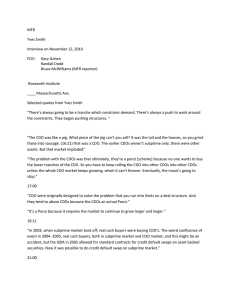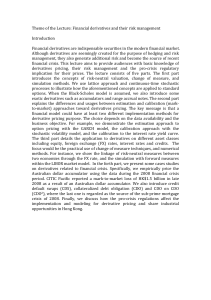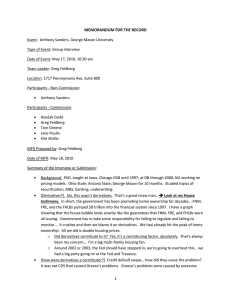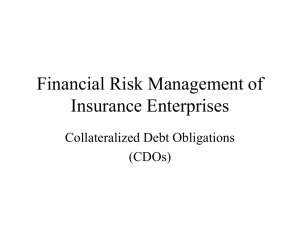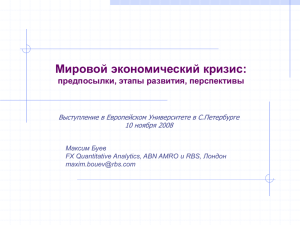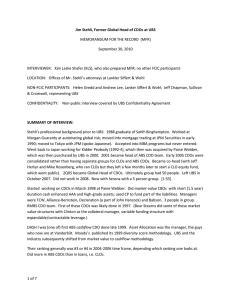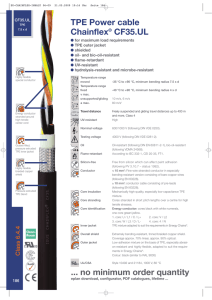Credit Default Swaps
advertisement
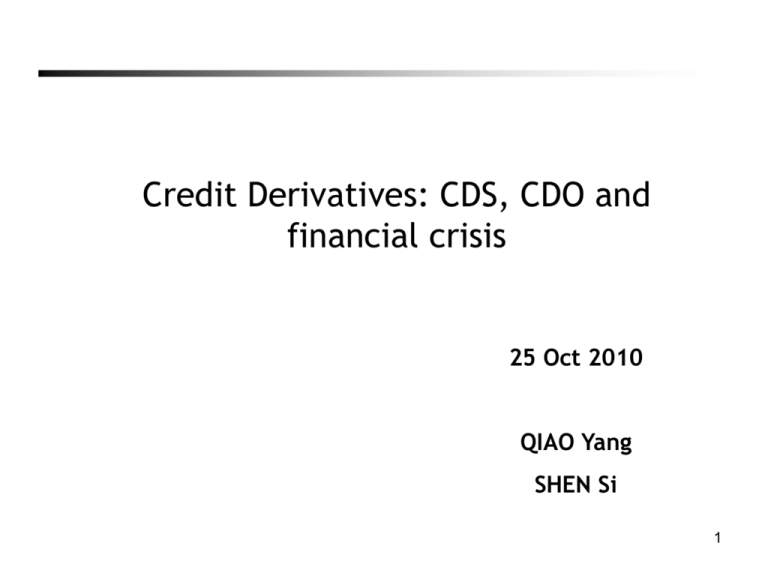
Credit Derivatives: CDS, CDO and financial crisis 25 Oct 2010 QIAO Yang SHEN Si 1 Agenda • Historical background: what is Credit Default Swaps (CDS) and Collateralized Default Obligation (CDO) • Issue and problem: risk valuation • How financial crisis is related to CDS and CDO • Approaches to address the issue: Regulatory development and central clearing • Future Direction 2 Credit Derivatives Basics • A credit derivative is a financial contract that allows one to take or reduce credit exposure, generally on bonds or loans of a sovereign or corporate entity. • Primarily used to: – express a credit view – reduce risk arising from ownership of bonds or loans • Credit derivatives – Credit Default Swaps – CDOs – Credit Indices – Nth-to-default basket – Credit-linked notes • Credit derivatives have become mainstream and are integrated with credit trading and risk management 3 Credit Default Swap/Insurance • Credit Default Swap have existed since early 1990s, it is an agreement between two parties to exchange the credit risk of an issuer (reference entity). • Buying insurance on Credit Events – an insurance policy on a risky asset. • Buying protection – insures against loss Default Protection Buyer • Selling protection - Collect fees/premium Periodically Interest Payment Par Value Payment (When Default) Default Protection Seller 4 CDS Parameters Which credit? •Reference obligation (Bonds, Loans, equity) Notional amount •Par value (e.g. USD 1 billion, SGD 500 million) Coupon •Fixed Coupon (e.g. 3% Semi Annual, 4% Quarterly) Spread •Annual payment (premium) quoted in bps •Spread =Coupon – benchmark rate (government bonds, indices, LIBOR) Maturity •Expiration of contract •3,5,7,10 years •5 year contract most liquid Recovery Rate •Depending on geographical region • empirical evidence 5 Collateralized Debt Obligations (CDOs) • CDOs are a type of asset backed security whose value and payments are derived from a portfolio of fixed-income underlying assets (bonds, loans, mortgages, etc.) • Split into tranches with different risk classes • First issued in 1987 by Drexel Burnham Lambert • Similar to fixed income securities: principal and interest payment • Usually constructed by creating a special purpose vehicle(SPV), a company that buys the underlying assets and issue CDOs backed by the assets Collateralized Debt Obligations (CDOs) Source: Bionicturtle.com 7 Pre-crisis CDS Market • Banks are the main players in CDS Market • Massive size of market 8 07-08 financial crisis in a nutshell • Capital easing policy, property market is hot • Banks inject loans into housing market • Banks sell loans to investors by packaging them in the form of CDOs • Housing market hotter, investors looking bullish, enter CDS on CDOs • Housing market collapsed, loan obligators default. Banks have no cash inflow, so banks default on CDOs, then investors default on CDS. • Capital market dries up, no liquidity. Banks, as the guys sitting at the middle of the CDO/CDS market, suffers from huge loss • Banks finally default, which triggers the global financial 9 crisis Issue with Credit Derivatives: Risk valuation • Lack of transparency: OTC contracts • Counterparty risk: Not easy to verify, SPV is separated from bank’s balance sheet, leads to incorrect credit rating • Heavy reliance on credit ratings made by credit rating agencies (Moody’s, S&P, Fitch) • In order to increase the transaction volume, banks set low credit requirements and perform poor credit checks. Resulting in inflated credit ratings. 10 How to address the issue? • Improve transparency – Details of OTC contracts to be disclosed • Tighter regulations and government supervisions – Central Clearing – New legislation act • Stricter risk control/credit evaluation – Higher credit requirement – Improve risk management – SPVs are reflected in balance sheet – Separation of prop trading house and underwriter 11 How to address the issue (Central Clearing) • Central Clearing: improve transparency, remove the counterparty risk. Source: IS423 Lecture Slides 4 12 Regulatory action to the issue • US, Frank-Dodd Legislation (July, 2010) – Limit excessive risk taking by banks including prop trading, hedge fund and private equity – Enhanced capital requirement for banks: 6% Tier 1 capital ratio and 10% total capital ratio. – Derivatives trading and clearing to be done through regulated exchanges. • International, Basel III – New and more stringent capital requirement – 7% core Capital and Total 10.5% by Jan 2019 – Legacy Tier1 capital and Tier 2 capital instruments will be phased out, and new capital requirement will be phased in 13 Future of Credit Derivatives • Traded and settled through regulated entity (Exchange or clearing house) • Lower risk appetite • Lower credit ratings which reflect the true risk of the derivatives • Market growing at a moderate pace 14 References • • • • “Options, Futures and other derivatives” 7th Ed, John C Hull, Prentice Hall “CDOs in plain English”, Nomura Securities “CDO Handbook”, JP Morgan Global Structured Finance Research “The Story of the CDO Market Meltdown: An Empirical Analysis”, Anna Katherine Barnett-Hart • Wikipedia- Credit Default Swap: http://en.wikipedia.org/wiki/Credit_default_swap#Risk • Wikipedia – Collateralized Debt Obligation : http://en.wikipedia.org/wiki/Credit_default_swap#Risk • IS 423 Lecture Slides 15
